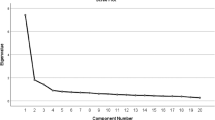Abstract
Factor analyses of child behavior problems have often yielded two broadband syndromes, Overcontrolled (e.g., worrying, fearfulness, withdrawal) and Undercontrolled (e.g., restlessness, fighting, disobedience). We explored whether these two broad-band syndromes might be identified for youngsters in Jamaica. We obtained teacher reports for 320 clinic-referred Jamaican youngsters on a 24-item problem checklist designed by Jamaican clinicians for the assessment of child behavior problems and subjected these to principal components analyses. Regardless of whether the sample was split according to age or sex, the analyses revealed factors similar to the Over- and Undercontrolled syndromes most often found in other cultures. The analyses also revealed school absence factors in each age and sex group; school avoidance was correlated with crying in children (aged 6–11) but with conduct problems in adolescents (aged 12–17). The findings suggest important similarities and possible differences between the factor structures of child behavior problems in Jamaica and the United States.
Similar content being viewed by others
References
Achenbach, T. M., & Edelbrock, C. S. (1978). The classification of child psychopathology: A review and analysis of empirical efforts.Psychological Bulletin, 85, 1275–1301.
Achenbach, T. M., & Edelbrock, C. S. (1986).Manual for the teacher's report form and teacher version of the child behavior profile. Burlington VT: University of Vermont Department of Psychiatry.
American Psychiatric Association. (1980).Diagnostic and statistical manual of mental disorders. (3rd ed.). Washington, DC: Author.
Cattell, R. B. (1952).Factor analysis. New York: Harper.
Dreger, R. M. (1981). The classification of children and their emotional problems.Clinical Psychology Review, 1, 415–430.
Dreger, R. M. (1982). The classification of children and their emotional problems-II.Clinical Psychology Review, 2, 348–385.
Dreger, R. M., Lewis, P. M., Rich, T. A., Miller, K. S., Reid, M. P., Overlade, D. C., Taffel, C., & Flemming, E. L. (1964). Behavioral classification project.Journal of Consulting Psychology, 28, 1–13.
Lambert, M. C. (1986).Clinic referral problems of Jamaican and American children: The culture general and culture specific. Unpublished master's thesis, University of North Carolina at Chapel Hill.
Lambert, M. C. (1987).Behavior problems of Jamaican children and adolescents: A comparison of parent and teacher ratings. Unpublished doctoral dissertation, University of North Carolina at Chapel Hill.
Linn, R. L. (1968). A Monte Carlo approach to the number of factors problemsPsychometrika, 33, 37–71.
Mattison, R., Cantwell, D. P., Russell, A. T., & Will, L. (1979). A comparison of DSM II with DSM III in the diagnosis of child psychiatric disorders.Archives of General Psychiatry, 36, 1217–1222.
Praxton, J. (1988).The statesman's yearbook 1988–1989: Statistical and historical manual of the states of the world. New York: Macmillan.
Quay, H. C. (1986a). Classification. In H. C. Quay & J. S. Werry (Eds.),Psychopathological disorders of childhood (3rd ed., pp. 1–34). New York: Wiley.
Quay, H. C. (1986b). A critical analysis of DSM III as a toxonomy of psychopathology in childhood and adolescence. In T. Millon & G. L. Klarman (Eds.),Contemporary directions in psychopathology (pp. 151–165). New York: Guilford Press.
Tucker, L. R., Koopman, R. F., & Linn, R. L. (1969). Evaluation of factor analytic research procedures by means of simulated correlation matrices,Psychometrika, 38, 1–8.
Zigler, E. F., & Child, I. L. (1982).Socialization and personality development. New York: Oxford University Press.
Author information
Authors and Affiliations
Additional information
This study was supported through grants from the University Research Council of the University of North Carolina at Chapel Hill and Sigma Xi, the Scientific Research Society, which we gratefully acknowledge. We thank Frank Knight, Patricia Smykle, Mary Desouza, Larry Galpert, Kathay Overly, and Bernadette Walter for this assistance with data gathering and data reduction.
Rights and permissions
About this article
Cite this article
Lambert, M.C., Weisz, J.R. & Thesiger, C. Principal components analyses of behavior problems in Jamaican clinic-referred children: Teacher reports for ages 6–17. J Abnorm Child Psychol 17, 553–562 (1989). https://doi.org/10.1007/BF00916513
Revised:
Issue Date:
DOI: https://doi.org/10.1007/BF00916513



